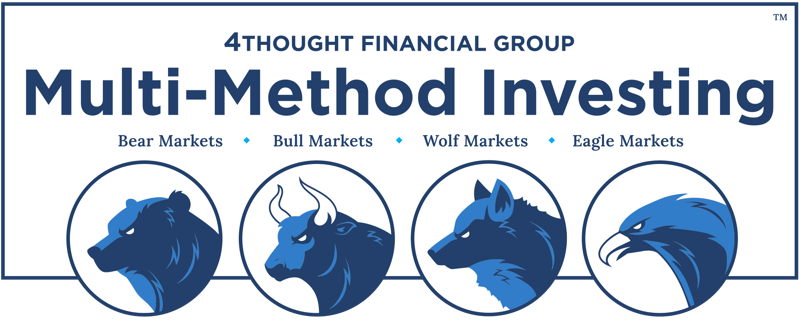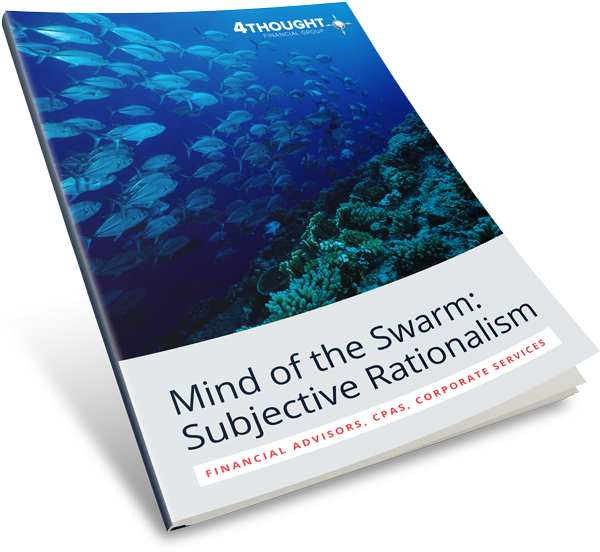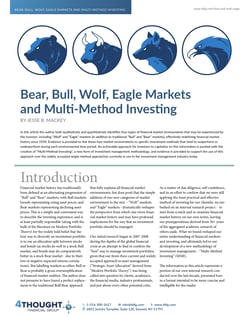

When we look at the world of investment management, we can break it down into 4 primary categories of investment method that can be used by an investor to attempt to achieve his or her goals. We’ve found through both proprietary and third party research that no single one of these methods is effective in all scenarios, but instead that each approach tends to have a particular market environment or part of the market cycle to which it is very well adapted. Our conclusion is that in order to achieve one’s life goals, one should diversify at the level of investment method, applying the most effective aspects of multiple completely divergent methods of investing, and not be dogmatic about using a single method.The broad categories of investment method can be seen as four pillars of a complete investment portfolio management methodology:
LDI is often used by large institutions such as banks, insurance companies, and pension funds.
It is based on the concept of directly matching investor assets with the entity’s known, quantifiable risks and liabilities in an attempt to transfer these (and possibly market-related risks) to another party. It often involves the heavy use of fixed income (bond) instruments, and possibly derivatives.
Strategic Asset Allocation is the most widely utilized and accepted method of investment, based on the original work of Harry Markowitz and his contemporaries in the academic community in developing Modern Portfolio Theory. In practice it involves setting a predetermined percentage split between stocks, bonds, and other asset types (an asset allocation); diversifying by asset type and number of securities as much as possible within these categories; and rebalancing back to the original splits as market values shift (making target allocation changes only as necessary based on changes in the investor’s objectives, risk tolerance, and life cycle).
This is by far the most ubiquitously used method in the robo-advisor and passive investment communities.
Opportunistic Investing is a very broad category that encompasses a vast number of sub-categories, all of them sharing the goals of beating the market (either on the upside, the downside, or both) or (such as in 4Thought’s case) providing low correlation returns with the more traditional stock/bond portions of an investor portfolio. Many hedge fund strategies fit in this category, as do tactical asset allocation approaches and absolute return strategies.
Based on our definition, opportunistic strategies are mainly focused on taking advantage of asset class market timing opportunities, and not necessarily on opportunities related to individual companies or stocks.
Selective or Concentrated Investing is the oldest form of investing, and involves taking positions in one or more individual companies or securities in an attempt to take advantage of some inefficiency related to the price of that security, to capitalize on an associated idiosyncratic risk of the stock, or in expectation of future growth in the company. Most private equity funds apply this method, as do the more selective “Value” and “Growth” styles of stock investing.
The basic idea is that by knowing as much as possible about the very few positions one is invested in and acting on information related to them, it may become possible to beat the market or a more diversified portfolio over the long term.

Characterized by investor fear and declining asset prices, a Bear market will be best attacked using Liability-Driven Investing.

Characterized by investor confidence and rising asset prices, a Bull market will be best attacked using Strategic Asset Allocation.

Characterized by investor uncertainty and volatile or sideways asset prices, a Wolf market will be best attacked using Opportunistic Investing.

Characterized by investor exuberance and soaring asset prices, an Eagle Market will be best attacked using Selective / Concentrated Investing.
Methodology White paper
- Jesse Mackey, 4Thought Financial Group Chief Investment Officer
We do not suggest that one attempt to predict which type of market environment is coming, but instead build a portfolio that may use multiple investment methods at the same time so that the overall portfolio is prepared for whatever contingency it may face. The question is: What methods should one use, when should one use them, and how much of each? The theoretical framework needed to answer this question is something we call Risk Premium Capital Allocation, which describes the optimal percentage allocation of an investor’s capital to various “Risk Premiums”. A “Risk Premium”, is the reward that can be captured by attacking a specific type of risk. The ability to capture different risk premiums is what we believe makes each of the 4 categories of investment management successful in their own respective Bear, Bull, Wolf, or Eagle market environment. We have identified four major risk premiums that may be capitalized on by investors:
These four risk premiums can be plotted on a chart to create an “efficient frontier” similar to the one used in Modern Portfolio Theory, that tells us the most optimal combination of risk premiums (and thus investment methods) for a range of investor objectives, and thus gives us our appropriate “Risk Premium Capital Allocation” (RPCA) for a given investor. The end result of creating and managing this multi-premium, multi-method approach is an aggregate investor portfolio that is better equipped to handle a much wider variety of market environments and contingencies. We believe that by doing the right investment planning and making practical investment decisions using the Risk Premium Capital Allocation theoretical framework we can help to increase the probability that an investor will achieve their financial goals.

Are the markets rational or irrational? Neither. Look to nature for guidance.
 FREE WHITE PAPER
FREE WHITE PAPER
4Thought is designed to guide you, so the more that we know about you the better we can guide you. Our platform allows you to sync your other investments with us so you see a complete snapshot of your total net worth and your other accounts, all in one place.

The information provided by 4Thought is educational only and is not to be interpreted or construed as investment or tax advice.
© 2025 4Thought Financial Group Inc.
Investment Advisory Services are offered through 4Thought Financial Group Inc.,
Registration does not imply a certain level of skill or training. The content presented here is for informational purposes only and does not constitute a complete description of our investment advisory services or performance. This website is in no way a solicitation or offer to sell securities or investment advisory services except, where applicable, in states where we are registered (or notice filed) or where an exemption or exclusion from such registration exists. Information throughout this site, including, but not limited to, stock quotes, charts, articles or any other statement or statements regarding market or other financial information, is obtained from sources which we, and our suppliers believe reliable, but we do not warrant or guarantee the timeliness or accuracy of this information. Nothing on this website should be interpreted to state or imply that past results are an indication of future performance. Neither we nor our information providers shall be liable for any errors or inaccuracies, regardless of cause, or the lack of timeliness of, or for any delay or interruption in the transmission thereof to the user. THERE ARE NO WARRANTIES, EXPRESSED OR IMPLIED, AS TO ACCURACY, COMPLETENESS, OR RESULTS OBTAINED FROM ANY INFORMATION POSTED ON THIS OR ANY LINKED WEBSITE.
Form CRS, Firm Brochure (ADV Part2), Privacy Policy Notice, and Wrap Fee Program Brochure Disclosure BrokerCheck
Any opinions presented here are subject to change at any time without notice. Any comments or postings are provided for informational purposes only and do not constitute an offer or a recommendation to buy or sell securities or other financial instruments. Readers should conduct their own review and exercise judgment prior to investing. Investments are not guaranteed, involve risk and may result in a loss of principal. Past performance does not guarantee future results. Investments are not suitable for all types of investors.
*4Thought Financial Group claims compliance with the Global Investment Performance Standards (GIPS®). GIPS® is a registered trademark of CFA Institute. CFA Institute does not endorse or promote this organization, nor does it warrant the accuracy or quality of the content contained herein. The GIPS firm definition excludes any third party asset management programs over which 4Thought maintains oversight advisory agreements on behalf of its clients, any arrangements under which 4Thought provides recommendations for client self-implementation, and any assets under advisory but not under direct management (in which 4Thought provides allocation changes or trading signals to third party firms but does not take discretion over the trading of client accounts). GIPS-compliant performance information for 4Thought's strategies may be obtained by email at info@4tfg.com; on the 4Thought website at www.4tfg.com/performance-requests; or by phone at (516) 300-1617.
Form CRS, Firm Brochure (ADV Part2), Privacy Policy Notice, and Wrap Fee Program Brochure Disclosure BrokerCheck
Investment Advisory Services are offered through 4Thought Financial Group Inc., an SEC Registered Investment Adviser.
Registration does not imply a certain level of skill or training. The content presented here is for informational purposes only and does not constitute a complete description of our investment advisory services or performance. This website is in no way a solicitation or offer to sell securities or investment advisory services except, where applicable, in states where we are registered (or notice filed) or where an exemption or exclusion from such registration exists. Information throughout this site, including, but not limited to, stock quotes, charts, articles or any other statement or statements regarding market or other financial information, is obtained from sources which we, and our suppliers believe reliable, but we do not warrant or guarantee the timeliness or accuracy of this information. Nothing on this website should be interpreted to state or imply that past results are an indication of future performance. Neither we nor our information providers shall be liable for any errors or inaccuracies, regardless of cause, or the lack of timeliness of, or for any delay or interruption in the transmission thereof to the user. THERE ARE NO WARRANTIES, EXPRESSED OR IMPLIED, AS TO ACCURACY, COMPLETENESS, OR RESULTS OBTAINED FROM ANY INFORMATION POSTED ON THIS OR ANY LINKED WEBSITE.
Any opinions presented here are subject to change at any time without notice. Any comments or postings are provided for informational purposes only and do not constitute an offer or a recommendation to buy or sell securities or other financial instruments. Readers should conduct their own review and exercise judgment prior to investing. Investments are not guaranteed, involve risk and may result in a loss of principal. Past performance does not guarantee future results. Investments are not suitable for all types of investors.
*4Thought Financial Group claims compliance with the Global Investment Performance Standards (GIPS®). GIPS® is a registered trademark of CFA Institute. CFA Institute does not endorse or promote this organization, nor does it warrant the accuracy or quality of the content contained herein. The GIPS firm definition excludes any third party asset management programs over which 4Thought maintains oversight advisory agreements on behalf of its clients, any arrangements under which 4Thought provides recommendations for client self-implementation, and any assets under advisory but not under direct management (in which 4Thought provides allocation changes or trading signals to third party firms but does not take discretion over the trading of client accounts). GIPS-compliant performance information for 4Thought's strategies may be obtained by email at info@4tfg.com; on the 4Thought website at https://www.4tfg.com/performance-requests; or by phone at (516) 300-1617.